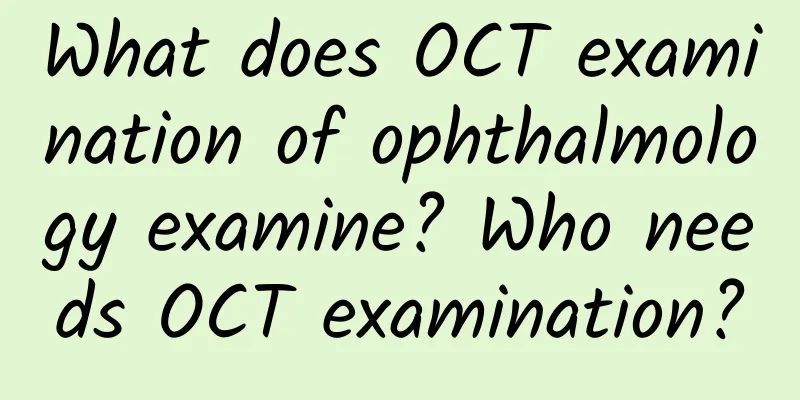What does OCT examination of ophthalmology examine? Who needs OCT examination?

|
What is OCT? "What is OCT? Is it the same as CT? Does it cause radiation?" The full name of OCT in Chinese is Optical Coherence Tomography, and its English name is OCT for short. It is an ophthalmic examination method that uses light waves as imaging. It is non-contact, non-invasive, highly sensitive and high-resolution. OCT examination can clearly show the morphological characteristics of the posterior segment of the eye, mainly the macula and optic disc, the interlayer structure of the retina, and the thickness changes of the retinal and neural microscopic layers. In addition, it can also observe the anterior segment tissues such as the cornea, iris, and lens , and accurately measure related data. In short, OCT examination of the macula is completely different from the CT examination we know, and there is no radiation. It is a fast, safe, non-invasive, and radiation-free ophthalmological examination. In what cases is an ophthalmic OCT examination necessary? 1. Macular disease OCT examination can show whether there are new blood vessels, defects or high reflective areas in each section. These areas in the image will cause various macular diseases, such as macular degeneration, epiretinal membrane, macular hole, choroidal neovascularization, etc. 2. Diabetic retinopathy The causes and course of diabetic retinopathy vary, but typical fundus changes at each stage can be shown on OCT, such as fundus punctate exudation, detachment of the central foveal neuroepithelium, hemorrhage, and cystoid macular edema. 3. Cataracts OCT is also a must-check item before and after cataract surgery. It provides guidance before surgery and can evaluate the patient's fundus condition after surgery. 4. Before and after laser myopia surgery The corneal thickness can be measured before surgery, and the corneal condition can be checked after surgery. 5. Corneal lesions It can check the condition of the cornea, such as corneal thickness, location of corneal lesions, corneal morphology, etc. Moreover, OCT does not touch the cornea, which is more convenient and comfortable, and plays an important guiding role in the diagnosis and treatment of corneal lesions. 6. Optic nerve disease OCT can show pathological changes that cannot or are difficult to detect by conventional fundus examination, such as varying degrees of thinning of the nerve fiber layer around the optic disc, thinning of the optic nerve fiber layer, and glaucoma cupping. 7. Severe myopia OCT can be used to determine whether the posterior retina is atrophic or thinning, whether there is retinal splitting and shallow retinal detachment, and whether there is vitreous macular traction. OCT examination is real-time imaging, high resolution, non-contact, non-invasive, and radiation-free. It is suitable for a wide range of people. Through this examination, ophthalmologists can diagnose, treat, and follow up diseases more accurately. OCT examination is a non-invasive examination. We remain seated during the examination and only need to place our eyes in the designated position. The intraocular structure can be clearly displayed on the OCT instrument screen, helping doctors to detect abnormalities in the eye in a timely manner. |
<<: The dark "present life" of a fatty liver, regret for the pitfalls of the "previous life"
Recommend
[Medical Q&A] What foods can help maintain energy and avoid nutritional deficiencies during weight loss?
Planner: Chinese Medical Association Reviewer: Ch...
Causes of constipation in women
There are many reasons for female constipation, a...
How long does it take for Chinese patent medicine to regulate endocrine to be effective?
Under the current stressful life and work pressur...
Can seborrheic alopecia in girls be cured?
Nowadays, many people suffer from seborrheic alop...
Orgasm in the left ear, cough in the right ear? Can this earwax still be removed...
I believe many people have had earwax removed and...
Is it true that the pregnancy test is accurate if the menstruation is not delayed?
Generally speaking, you can do a pregnancy test o...
Why do pregnant women feel nausea and vomiting?
When a woman becomes pregnant, her body will have...
Can you still have children after hydatidiform mole?
The process of women's pregnancy and childbir...
How to deal with the H1N1 flu outbreak? Is it too late to get vaccinated now?
Although everyone has made some preparations to d...
What is the reason for the jerking when shifting from first gear to second gear in manual transmission? Is it a problem of the car if there is a jerking feeling when shifting from first gear to second gear?
When shifting gears in a manual transmission car,...
Causes of high cholesterol during pregnancy
We all know that the body of every pregnant mothe...
Can a mother's mental illness be passed down to her daughter?
When men and women with mental illness give birth...
What are the benefits of vaginal tightening surgery?
Mothers will gradually become cold to their partn...
Never know when your next period will come? Will you gain weight just by drinking water? Obstetricians and gynecologists teach you how to understand polycystic ovary syndrome with one picture!
Content from : Gu Zhuowei Shanghai Jiao Tong Univ...
Causes of breast pain during lactation
I believe many mothers have experienced the feeli...









